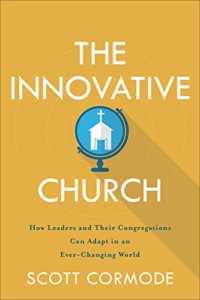Why are churches so resistant to meaningful change? And what processes can help churches be more agile and innovative? Ann Michel of the Lewis Center shares key concepts in Scott Cormode’s book The Innovative Church about innovation and change.
Why are churches so resistant to meaningful change? Yes, many are old, set in their ways, and inwardly focused. But in his new book The Innovative Church (Baker Academic, 2020), Scott Cormode explains a more systemic cause of congregational intransigence. The church’s core purpose is to perpetuate received traditions and unchanging beliefs. The church as we know it, he writes, is “calibrated for a world that no longer exists.” And the ways we typically attempt change — with gimmicks and quick fixes or grand ideas and visions — are prone to failure.
Change in the church requires a more subtle and persistent approach that includes deep listening, reshaping the mental models and shared meanings, telling new stories, reimagining ancient practices, scattering the seeds of many potential new ideas, and seizing the positive momentum of small steps forward.
Understanding innovation
Cormode also explains that we often operate with flawed notions about how change occurs. Our dominant cultural narratives see change as something that happens almost magically through the work of solitary geniuses and visionary leaders or through serendipitous “eureka moments.” These myths blind us to the fact that change is a collaborative effort that rarely succeeds when we risk everything on a single bold idea. “Ideas are like saplings,” Cormode writes. “You grow them in numbers.” Like the sower in Jesus’s parable, we must scatter many seeds for some to take root and grow.
A leader’s job is to plant, water, and nurture seeds of change. But growth also depends on the fertile soil of an organizational culture that is clear about its ultimate purpose and values, that fosters collaboration among people with diverse perspectives and experiences, that experiments and learn from their discoveries, and that has an effective process for managing ideas and decisions.
A four-part change process
Drawing on his own work to cultivate innovation with young Christians, Cormode posits a four-part innovation process that combines timeless Christian practices, such as discernment and lament, with current ideas about change drawn from the secular world, such as human-centered design.
1. Empathic listening is the first critical step. It involves listening to God, to Scripture, to our communities, and to the people entrusted to our care. This is more than casual conversation. It seeks to bridge divisions and understand people’s longings and losses through a posture of empathy and openness. Its purpose is to assure that innovation connects to people’s lived experiences.
2. Divergent ideation comes next. The goal is to generate lots of ideas in a short period of time. Three words are critical: how, might, and we. Again, openness is key. No idea should be dismissed for fear that it is too large or unworkable.
3. Convergent deciding is the process of deciding which of the many ideas to pursue. While the previous step emphasized generating as many separate ideas as possible, here the goal is to bring them together. Is there one idea that holds the others together? That weaves them into a coherent whole or a single goal?
4. Experimental prototyping then tests the idea further. This phase considers how that plan will take shape and what is needed to advance the experiment. It puts together a plan that can be tested.
While this process requires time and effort, figuring out what needs to be done and making plans to do it is really the easy part. Cormode is clear-eyed about the fact that the work of actually making it happen is much more difficult.
The leadership challenge
We often see change as a task we take on for a season. Once we’ve checked it off our to-do list and altered our course a bit, we want to continue down that new road, hopefully for some time, before again entertaining the need for change. The Innovative Church invites us to think more broadly about the nature of change itself. We can no longer assume a predictable future. Change is an ongoing process. Innovation is a way of being, not an occasional interlude in the otherwise placid life of a congregation.
Church leaders face the daunting task of helping to orchestrate change with people, often including themselves, who desperately need change but just as desperately want to avoid it. It requires discipline, determination, and skills rarely emphasized in the preparation for ministry. The Innovative Church reminds us that prepared, agile, self-reflective leaders are critical to successful change, and that those called to lead the church must claim responsibility for equipping themselves with the practices and perspectives necessary to guide it to a new future.
 The Innovative Church: How Leaders and Their Congregations Can Adapt in an Ever Changing World (Baker Academic, 2020) is available from Baker Publishing Group and at Cokesbury and Amazon.
The Innovative Church: How Leaders and Their Congregations Can Adapt in an Ever Changing World (Baker Academic, 2020) is available from Baker Publishing Group and at Cokesbury and Amazon.
Related Resources
- Recalibrating the Church, a Leading Ideas Talks podcast episode featuring Scott Cormode
- Take the Next Step: Leading Lasting Change in the Church by Lovett H. Weems, Jr
- 5 Ways to Overcome Common Obstacles to Change by Daniel M. Cash and William H. Griffith







